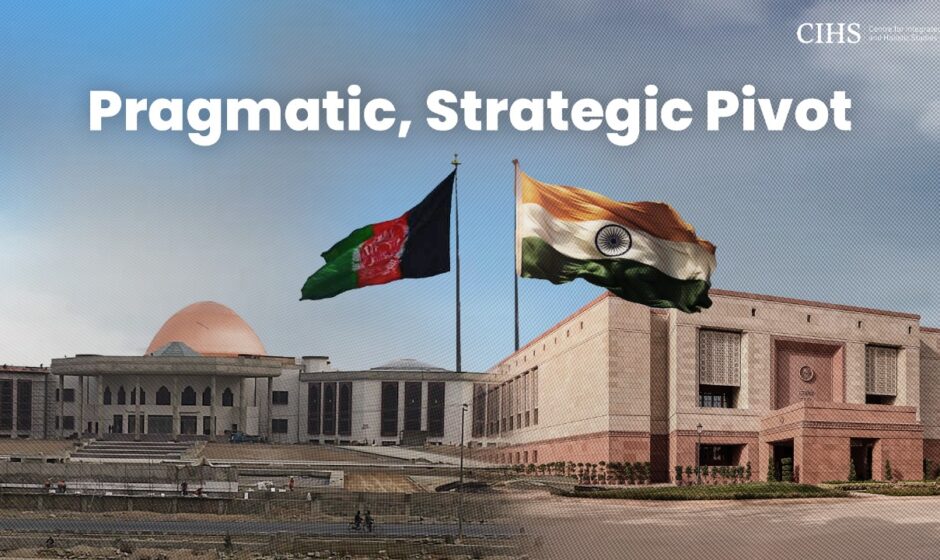Muttaqi’s visit marks a milestone; opens up opportunity for Bharat to regain its presence in Afghanistan, keep a vigil on China, Pak & US.
Brig Brijesh Pandey

Bharat’s engagement with Afghanistan has historically been shaped less by cultural outreach and more by hard security imperatives. The strategists in New Delhi have long understood that Afghanistan occupied the only viable land corridor for India to access Central Asia and the vast Eurasian heartland – an assessment that predates independence.
From King Zahir Shah’s regime to its support for Northern Alliance, Bharat consistently aligned with political and military factions in Kabul that counter-balanced Pakistani influence. After 2001, Bharat emerged as one of the most critical development partners, constructing Zerang – Delaram highway, Parliament complex and Salma dam while training Afghan national army officers.

These initiatives were not driven purely by humanitarian considerations; they also reflected a calibrated strategy to ensure that a friendly government in Kabul could undercut Pakistan’s pursuit of exclusive strategic depth to its West.
Re-Engaging Taliban Regime
Taliban’s return to power in 2021 created a significant operational void due to Bharat’s absence from Afghan soil. With diplomatic staff evacuated and intelligence linkages abruptly severed, India’s continental outreach was overly reliant on external nodes such as Chabahar Port.
It is with this strategic calculus that recent visit of Taliban Foreign Minister Amir Khan Muttaqi to India must be assessed. Away from media portrayal, the visit carries far deeper operational and strategic implications.
Bharat’s foreign office made it explicit that formal recognition of Taliban Regime was not on the table, but structured engagement, certainly is. External Affairs minister, S. Jaishankar stated, “India will engage with authorities in Kabul based on our national interests and regional security priorities,” underscoring that New Delhi’s approach is based on pragmatic realpolitik rather than ideological endorsement.
Up-gradation of technical mission in Kabul to a fully functional Embassy should be read as a move to re-activate intelligence networks and re-establish Bharat’s influence inside Afghanistan’s evolving power structure.
For Taliban leadership, visit of its Foreign Minister to New Delhi served a different purpose. Before departing from Kabul, Muttaqi stated “Afghanistan seeks constructive relations with all regional countries including India” and during his interaction in Delhi, he expressed a desire to “open doors for economic cooperation, particularly through Chabahar.”
These formulations signal a deliberate attempt by Kabul to reduce its excessive dependence on Pakistan and China by establishing a channel of engagement with India. By doing so, Taliban wants to diversify external partnerships and in turn enhance their strategic bargaining leverage in the region.
Military Implications of Muttaqi’s Visit
The visit was preceded by a series of regional developments that cumulatively restricted India’s maneuverability – US strikes on Iranian nuclear infrastructure, Washington’s renewed embrace of Pakistan, Saudi- Pakistan Mutual Defence Agreement, US decision to withdraw sanctions waiver on Chabahar, escalating tariff related issues between US, China and US – India. Each of these chipped away at India’s continental outreach and signaled covering of ground by Pakistan in US calculations.
In this backdrop, reactivation of India’s Kabul Embassy must be taken as more than a symbolic gesture. It represents a well thought out step towards regaining ground presence – restoring Human Intelligence (HUMINT) channels, conducting security risk audits for Indian- funded projects and improving real time surveillance over terrorist movements along Nangarhar – Kandahar axis.
Traditional Indian threat assessment models for Kashmir and key Indian cities have had footprints in Afghanistan based launch pads and training camps. Moreover, India’s development projects create local employment, subtly shaping internal security dynamics of Afghanistan in Bharat’s favour.
Pakistan’s Attempt to Disrupt the Visit
Even as Amir Khan Muttaqi was in New Delhi, Pakistan attempted to register its discomfort by escalating military pressure along the Durand Line. Cross border firing was initiated by Pakistani forces in sectors such as Kurram, Angoor Adda and Spin Boldak, possibly expecting that Taliban would either remain passive or align with Islamabad’s position.
Taliban response defied those expectations. Taliban border units responded with direct fire and aggressive action overrunning number of Pakistani border outposts in select sectors. Though limited in scale, the tactical outcome held strategic significance.
Exchange may not have been high on scale but during his press interaction in New Delhi, Muttaqi stated “Afghanistan desires peaceful and sovereign relations with all neighbours. No country should interfere in Afghan affairs or expect Afghanistan to serve other country’s strategic agenda.” Without naming, the message was clearly directed at Pakistan’s long-standing expectation that Afghanistan would remain within its security orbit.
Security Tremors in Pakistan
The events have accentuated Pakistan’s existing fault lines in internal and external security grid:
- Durand Line Pressure Belt (Kurram, Angoor Adda & Spin Boldok). Taliban pushback has punctured Pakistani narrative that Afghanistan remains with its strategic depth doctrine. As per Rawalpindi directives, Pakistan is addressing this flash point using artillery and air strikes, inflaming anti-Pakistan sentiment in Afghanistan.
- Khyber Pakhtunkhwa Insurgency Arc (Swat Valley, Bajaur and Dera Ismail Khan). Taliban attacks along border have boosted the morale of TTP resulting in intensified attacks in these areas. This has compelled Pakistan to reinforce these areas using troops from Punjab and Baluchistan. This thinning of troops from its Eastern borders complicated Pakistan’s ability to respond to Bharat’s extended action as part of Operation Sindoor.
- Balochistan & CPEC Security Corridor. Chinese personnel, convoy routes and mineral extraction sites face constant threat from Baluchistan Liberation Army /Baluchistan Liberation Front. Beijing is pushing Pakistan to allow PLA linked private security entities which will face domestic backlash and US scrutiny.
- Gilgit Baltistan, Pakistan occupied Kashmir (PoJK) unrest: Popularresistance has escalated into violent protests, tying down internal security resources. Urban insurgency cells have got activated in Lahore, Islamabad and Karachi, straining Pakistan’s already stretched architecture. To make things worse, civil-military friction continues to widen.

US Factor
When questioned about India’s re-engagement with Kabul, a US State Department spokesperson said, “we expect regional actors to ensure that Afghanistan does not become a platform for instability. ” a carefully worded statement that neither endorses India’s outreach nor objects to it. Having suffered strategic withdrawal from Bagram Air Base and lacking boots on ground, tacitly sees value in limited Indian re-entry as a counter-weight to China-Pakistan axis. Yet it remains cautious about India-Iran logistical coordination through Chabahar, especially if it entails dual use military corridor.
India Aims Re-entry Not Recognition
In military terms, India is not seeking dominance or regime endorsement in Afghanistan but sustainable operational access. Intelligence depth and denial of Pakistani leverage is what remains critical for India, particularly after US-Pakistan embrace. The re-opening of Kabul Embassy is first step towards ensuring long term security interests. With Bagram under Taliban control and Chinese evaluation of the air base for dual use, this theatre is undergoing a shift that demands Indian presence, though a calibrated one for now.
India’s Security Concerns
Taliban still shelters ideological and operational elements that align with anti-India terror infrastructure. Pakistan, on the other hand retains the option of re-directing proxy assets towards Kashmir as asymmetric retaliation for India’s outreach to Kabul.
If Chabahar – Zahedan corridor becomes fully operational without disruption, it could bypass Pakistan entirely, fundamentally altering the continental logistics grid. Pakistan is likely to increase irregular warfare and sabotage operations along the Afghan frontier to disrupt this axis.
India cannot secure Afghan compliance merely through rhetoric or developmental aid. It will require permanent on-ground posture, layered engagement and readiness to effectively navigate an operational theatre populated by ISI assets and Chinese intelligence footprints.
For India, Pakistani adventurism on Kashmir front must be met. This explains why Operation Sindoor remains paused, not terminated.
Positional Contest Begins
This phase of engagement is not diplomatic closure but the beginning of a long-term positional contest. India’s objective is clear – to regain a strategic foothold in Kabul that serves as a forward intelligence hub, a redundancy corridor for logistics and a pressure lever against China-Pakistan collusive scenario.
Above all, it marks a doctrinal departure from Pakistan’s long-unchallenged belief that Afghan territory will remain an extension of its western strategic depth narrative.
(Author is a defence analyst, former military advisor and commanded an artillery brigade)


